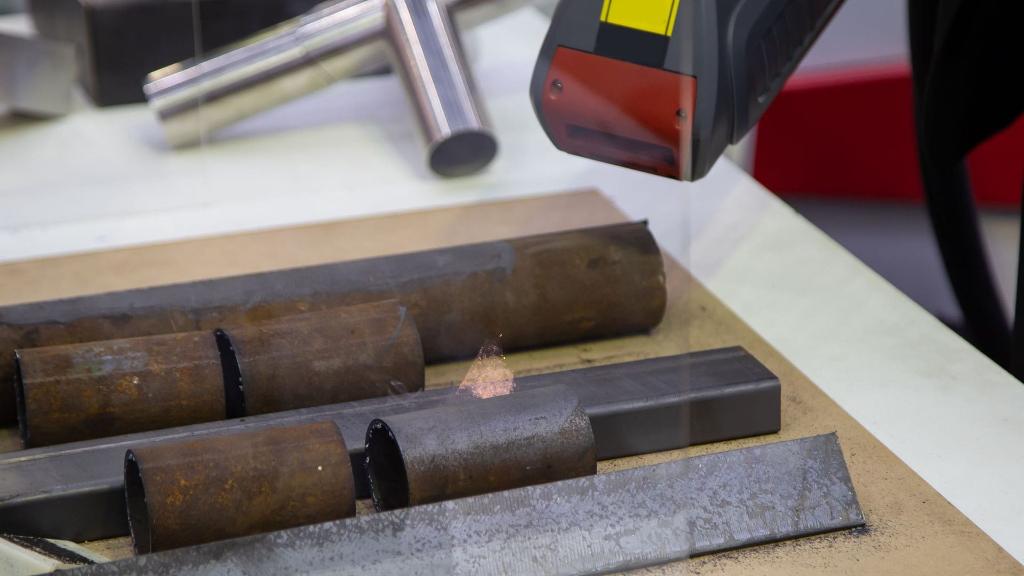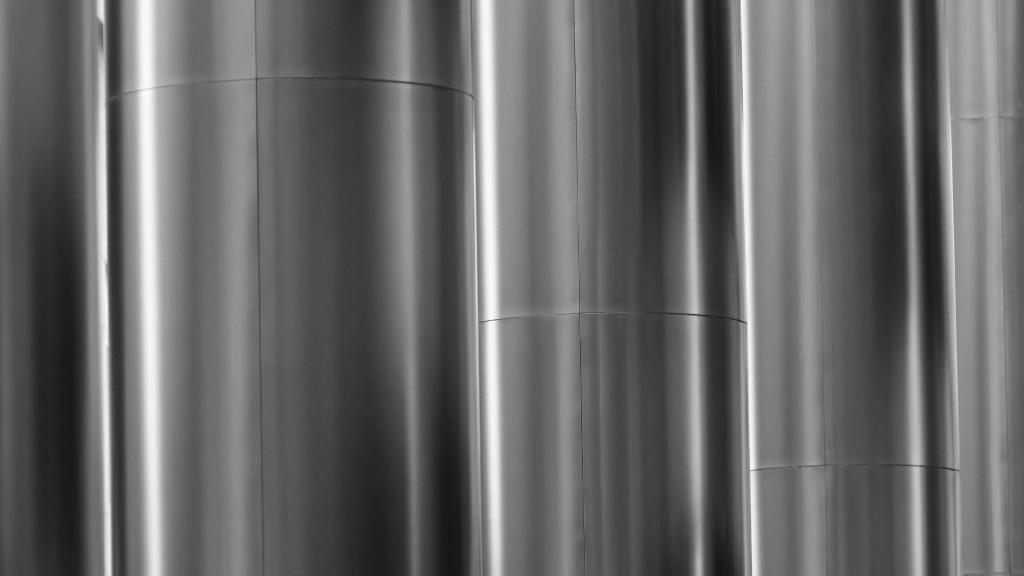Imagine a world where grime, rust, and other stubborn contaminants can be removed without the use of harsh chemicals or abrasive materials. A world where cleaning is as simple as pointing a handheld device at a surface and activating a beam of light. Sounds too good to be true, right? Well, welcome to the world of laser cleaning, where all of this is a reality.
Laser cleaning (also commonly referred to as laser ablation) is a non-contact, non-abrasive process used for removing contaminants, such as rust, paint, and oxides from various surfaces by using a highly focused laser beam. It’s a process that’s quickly becoming a significant player in many industrial sectors due to its superior efficiency, environmental friendliness, and versatility.
Defining the Laser Cleaning Process
At its core, the laser cleaning process is all about exploiting the properties of light to remove unwanted contaminants from surfaces. The process starts with a properly calibrated laser solution, which directs a laser beam onto the surface to be cleaned.
The laser’s energy is absorbed by the contaminants, causing a rapid rise in temperature. This abrupt heating results in what is known as laser ablation, which is essentially the evaporation or sublimation of the contaminant. This high-precision process doesn’t affect the underlying substrate, as the energy level and pulse duration can be carefully controlled to limit the ablation to the contaminated layer only.
This powerful cleaning method is often preferred over traditional cleaning methods, such as abrasive blasting or chemical solvents, due to its effectiveness and environmental friendliness.
What Materials Can Be Laser Cleaned?

When it comes to the versatility of laser cleaning technology, the range of materials that can benefit from this process is extensive. From metals to fabrics and everything in between, laser cleaning solutions have proven to be effective. Let’s take a closer look at some of these materials and typical use cases.
Metals
Laser cleaning systems have found widespread use in the restoration and maintenance of metal surfaces. Metals such as steel, aluminum, copper, and brass can be cleaned using lasers. This is often used for:
Rust and oxide removal
Coating removal for welding or bonding preparation
Cleaning of automotive parts
Restoration of historical metal artifacts
Maintenance of industrial equipment
Plastics
Various types of plastics, including acrylic, polycarbonate, and ABS, can also be effectively cleaned with lasers. This non-damaging process can remove coatings, adhesives, and contaminants, and is commonly used for:
Cleaning fiber reinforced polyurethane in automotive and aerospace applications
Surface preparation for bonding or painting
Mold cleaning in plastic manufacturing
Removal of paint or ink from plastic surfaces
Cleaning of medical devices
Glass

Glass, with its sensitive and potentially fragile nature, can greatly benefit from the non-contact cleaning power of lasers. Laser cleaning is suitable for cleaning glass surfaces, including windows, lenses, and optical components, without causing scratches or damage. Typical use cases include:
Cleaning of optical lenses in electronics and eyewear manufacturing
Removal of deposits or coatings from architectural glass
Restoration of stained glass artworks
Cleaning of glassware in laboratory or medical contexts
Maintenance of solar panels
Wood

Wood surfaces, due to their porous nature, can be difficult to clean with traditional methods. However, lasers offer an effective solution for cleaning wood surfaces without causing undue damage. Examples of use cases include:
Restoration of wooden artifacts and furniture
Removal of paint, varnish or stain in preparation for refinishing
Cleaning of wooden building structures
Mold removal from wooden surfaces
Maintenance of wooden decks or patios
Stone and Concrete
Laser cleaning has made a significant impact in the care and restoration of historical and architectural stone and concrete surfaces. This technology allows us to remove dirt, mold, pollutants, graffiti, and other unwanted substances from the surface of stone and concrete without causing damage to the substrate.
By adjusting the parameters of the laser, it can be finely tuned to deal with different types of stone and concrete surfaces, from sensitive sandstone to resilient granite.
Typical use cases for laser cleaning of stone and concrete include:
Restoration and cleaning of historical monuments and statues
Removal of graffiti from public buildings and structures
Cleaning of architectural surfaces like building facades
Removal of stains and coatings from walkways and driveways
Restoration of stone statues and monuments in cemeteries
Ceramic and Porcelain

Ceramic and porcelain are common materials in various industries, from manufacturing and construction to art and design. They are known for their hardness and durability, but they are also prone to contamination and staining.
Laser cleaning is an efficient method to remove contaminants, stains, and residues from ceramic and porcelain surfaces without causing any damage. By adjusting the laser’s power and frequency, contaminants on the surface can be selectively removed, leaving the underlying ceramic or porcelain untouched.
Common applications of laser cleaning on ceramics and porcelain include:
Cleaning tiles in bathrooms and kitchens
Restoration of ceramic artworks and pottery
Removal of production residues from newly produced ceramic parts
Cleaning of ceramic components in various machines and equipment
Restoration of porcelain antiques
Next, we move into the realm of metals, looking at both ferrous and non-ferrous variants.
Ferrous Metals
Ferrous metals, such as iron, steel, and stainless steel, are among the most commonly used materials in industries like manufacturing, automotive, and construction. These metals are susceptible to rust, paint, and oxide layers that can affect their function and appearance.
Laser cleaning is a highly effective solution for these challenges. By utilizing a properly calibrated laser solution, rust, paint, and oxides can be removed from metal surfaces without causing physical damage or altering their properties.
Laser cleaning is commonly used on ferrous metals for:
Restoring automotive parts
Cleaning and preparation of surfaces for welding or bonding
Removing rust from structures and machinery
Cleaning of steel molds in various manufacturing processes
Restoration of antique ironwork
Non-Ferrous Metals
Non-ferrous metals, including aluminum, copper, brass, and titanium, also benefit from the precision and control of laser cleaning. These metals are often used in applications where their aesthetic appearance is important, such as jewelry, decorative items, or high-tech equipment.
Here are some typical use cases of laser cleaning for non-ferrous metals:
Cleaning of electrical contacts and circuit boards
Restoration of antique copper or brass items
Surface preparation for bonding or painting
Cleaning of aluminum molds in the food industry
Removal of oxide layers from titanium parts in the aerospace industry
In the next section, we will explore how laser cleaning applies to various alloys.
Alloys

Alloys, a combination of different metals, are widely used across industries such as aerospace, automotive, and manufacturing. These materials often have unique properties that can be compromised by contaminants, oxides, or unwanted coatings.
Laser cleaning provides a high-precision solution for alloys, focusing on the unwanted layers while preserving the integrity of the underlying material. This method ensures that the valuable properties of the alloy are retained while the surface is cleaned and prepared for further processing or use.
Typical applications of laser cleaning for alloys include:
Cleaning of engine components in automotive and aerospace industries
Preparation of alloy surfaces for bonding or painting
Removal of oxide layers from alloy parts
Cleaning of alloy molds and dies in manufacturing industries
Restoration of antique alloy items
Composites
In the world of materials, composites are a fascinating group. A composite is a material made from two or more constituent materials with significantly different physical or chemical properties that, when combined, produce a material with characteristics different from the individual components. Composites can be made from a blend of materials such as plastics, metals, and even ceramics, thus broadening the scope for their application.
Laser cleaning is well-suited for composites, considering the diverse nature of the materials involved. From carbon fiber composites to other complex mixtures used in aerospace, automotive, and manufacturing sectors, laser cleaning provides an effective solution to remove contaminants and unwanted residues.
Below are a few examples of how laser cleaning is applied to composites:
Resin residue removal from carbon fiber composites
Cleaning of composite surfaces before bonding in manufacturing
Preparation of composite materials for adhesive bonding in aerospace industries
Restoration of composite-based artifacts and antiques
Removal of coatings and contaminants from automotive composite parts
H3 Rubber
Rubber, in its many forms, is omnipresent in numerous industries. From the automotive and aerospace sectors to manufacturing and sports equipment, the usage of rubber is diverse. Laser cleaning can prove to be an efficient method to remove dirt, adhesives, and other contaminants from various types of rubber.
Here are some notable uses of laser cleaning on rubber:
Cleaning rubber tires in the automotive industry, removing dirt, brake dust, and other debris from tire surfaces
Removal of adhesives and residues from rubber seals in manufacturing processes
Cleaning rubber components in aerospace applications
Restoration of antique or vintage items made of rubber
Removal of paint or coatings from rubber surfaces
Fabrics and Textiles
Fabrics and textiles envelop us daily, from the clothes we wear to the upholsteries we touch, and to the beddings we sleep on. When it comes to these types of materials, laser cleaning provides a specialized approach to removing stains, dyes, coatings, and other contaminants without damaging the fabric structure.
Here are some notable applications of laser cleaning on fabrics and textiles:
Restoring historical or valuable fabric items, such as tapestries and antique rugs
Removal of stains and contaminants from delicate fabrics without causing physical damage
Preparation of textiles for dyeing or printing processes in the fashion industry
Cleaning of upholstery fabrics in automotive or furniture applications
Decontamination of fabrics in medical and healthcare sectors
Paper
Paper, an often-overlooked material, also benefits from the delicate touch of laser cleaning. With the need to preserve paper documents, books, and artworks, laser cleaning presents a non-contact method that effectively removes dirt, ink stains, and other unwanted substances.
Examples of laser cleaning applications on paper include:
Restoration of historical books and documents
Removal of ink stains from paper materials without causing discoloration or damage
Cleaning of paper artworks and drawings
Decontamination of archival documents in libraries and museums
Removing old varnish from antique paper items
Next up, we return to the realm of automotive with rubber tires.
Rubber Tires

The automotive industry frequently utilizes laser cleaning, especially when it comes to rubber tires. These black, sturdy rings of rubber collect dirt, brake dust, and other debris from the road, impacting their appearance and performance. Laser cleaning offers an efficient and environmentally-friendly solution, as it can remove such contaminants without any physical contact or damage.
Here are several use cases of laser cleaning for rubber tires:
Cleaning of newly manufactured tires in automotive production lines
Removal of brake dust and road grime from car tires in car detailing services
Restoration of used tires for resale
Decontamination of tires in racing sports to enhance their grip and performance
Preparation of tires for quality inspection in tire manufacturing
Carbon Fiber
Carbon fiber, renowned for its strength and lightness, has found a home in various sectors, including aerospace, automotive, and sporting goods. Laser cleaning, owing to its precision and gentleness, can effectively remove resin residue, release agents, and contaminants from carbon fiber materials, a task traditional methods might find challenging.
The following use cases depict the versatility of laser cleaning on carbon fiber materials:
Removal of release agents from carbon fiber parts in aerospace manufacturing
Cleaning of carbon fiber components in automotive production
Restoration of sports equipment, such as bicycles and tennis rackets, made from carbon fiber
Preparation of carbon fiber surfaces for further processing, such as painting or coating
Decontamination of carbon fiber parts in high-tech industries
As we transition from man-made materials, we take a step back to examine the cleaning of natural stone.
Natural Stone
Natural stone, with its timeless aesthetic and durability, is a popular material used in a variety of applications, from construction to interior design. However, it can often be challenging to maintain its natural beauty due to the accumulation of grime and environmental elements. Laser cleaning provides a precise, effective solution to rejuvenate natural stone without causing damage.
A few use cases of laser cleaning for natural stone include:
Restoration of historical monuments and statues
Removal of graffiti from stone walls and building facades
Cleaning of natural stone surfaces in construction and restoration projects
Removal of moss and algae from stone garden paths and patios
Cleaning and maintenance of stone fireplaces and countertops
What materials are not suitable for laser cleaning?

While laser cleaning has revolutionized the way we approach surface cleansing, it is not a one-size-fits-all solution. Certain materials may not be appropriate for this method due to their sensitivity, light absorption properties, or inability to withstand the thermal effects of the laser beam.
The following materials are typically unsuitable for laser cleaning, for various reasons:
Certain thin plastics: Some types of thin plastics may warp or melt due to the heat generated by the laser.
Certain types of glass: Not all glass surfaces are appropriate for laser cleaning. Some, like certain thin glass types, may crack due to thermal stress.
Heat-sensitive materials: Materials that are sensitive to heat, such as certain types of adhesive films and thin foils, may be damaged by the thermal effect of the laser.
Highly reflective metals: Some metals, such as polished stainless steel or aluminum, can reflect the laser beam, making the cleaning process inefficient.
Certain organic materials: Organic materials, like leather or certain types of fabric, may discolor or burn when exposed to laser cleaning.
While it is essential to understand the limitations of laser cleaning, it is equally crucial to acknowledge the progress and flexibility it has brought to a wide variety of industries. This method of cleaning offers a highly precise, efficient, and environmentally friendly solution that is transforming the way we maintain and restore materials.
Conclusion
In conclusion, laser cleaning is a transformative technology reshaping surface cleaning across various industries. While exceptionally versatile, its use is not universal, with some materials ill-suited for this method.
Despite these limitations, laser cleaning’s precision, effectiveness, and eco-friendliness make it an invaluable tool. It rejuvenates a broad range of materials, from industrial machinery to historical monuments, showcasing its potential.
As technology advances, so does our capacity to maintain and preserve the world’s diverse materials, a future undoubtedly brightened by the laser cleaner’s beam.